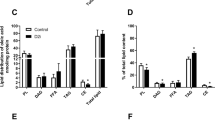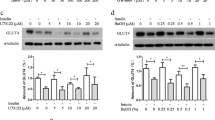Abstract
Sulfo-N-succinimidyl esters of LCFAs are a powerful tool to investigate the functional significance of plasmalemmal proteins in the LCFA uptake process. This notion is based on the following observations. First, sulfo-N-succinimidyl oleate (SSO) was found to inhibit the bulk of LCFA uptake into various cell types, i.e. rat adipocytes, type II pneumocytes and cardiac myocytes. Second, using cardiac giant membrane vesicles, in which LCFA uptake can be investigated in the absence of mitochondrial β-oxidation, SSO retained the ability to largely inhibit LCFA uptake, indicating that inhibition of LCFA transsarcolemmal transport is its primary action. Third, SSO has no inhibitory effect on glucose and octanoate uptake into giant membrane vesicles derived from heart and skeletal muscle, indicating that its action is specific for LCFA uptake. Finally, SSO specifically binds to the 88 kDa plasmalemmal fatty acid transporter FAT, a rat homologue of human CD36, resulting in an arrest of the transport function of this protein.
In addition to its inhibitory action at the plasma membrane level, evidence is presented for the lack of a direct inhibitory effect on subsequent LCFA metabolism. First, the relative contribution of oxidation and esterification to LCFA uptake is not altered in the presence of SSO. Second, isoproterenol-mediated channeling of LCFAs into oxidative pathways is not affected by sulfo-N-succinimidyl palmitate (SSP). As an example of its application we used SSP to study the role of FAT/CD36 in contraction- and insulin-stimulated LCFA uptake by cardiac myocytes , showing that this transporter is a primary site of regulation of cellular LCFA utilization.
Similar content being viewed by others
References
van der Vusse GJ, van Bilsen M, Glatz JFC: Cardiac fatty acid uptake and transport in health and disease. Cardiovasc Res 45: 279–293, 2000
Hamilton JA, Kamp F: How are free fatty acids transported in membranes? Is it by proteins or by free diffusion through the lipids? Diabetes 48: 2255–2269, 1999
Hamilton JA: Fatty acid transport: difficult or easy? J Lipid Res 39: 467–481, 1998
Hamilton JA, Johnson RA, Corkey B, Kamp F: Fatty acid transport: The diffusion mechanism in model and biological membranes. J Mol Neurosci 16: 99–108, 2001
Glatz JFC, Storch J: Unravelling the significance of cellular fatty acidbinding proteins. Curr Opin Lipidol 12: 267–274, 2001
Stremmel W: Fatty acid uptake by isolated rat heart myocytes represents a carrier-mediated transport process. J Clin Invest 81: 844–852, 1988
Luiken JJFP, van Nieuwenhoven FA, America G, van der Vusse GJ, Glatz JFC: Uptake and metabolism of palmitate by isolated cardiac myocytes from adult rats: Involvement of sarcolemmal proteins. J Lipid Res 38: 745–758, 1997
Abumrad NA, Park JH, Park CR: Permeation of long-chain fatty acid into adipocytes. Kinetics, specificity, and evidence for involvement of a membrane protein. J Biol Chem 259: 8945–8953, 1984
Bonen A, Luiken JJFP, Liu S, Dyck DJ, Kiens B, Kristiansen S, Turcotte LP, van der Vusse GJ, Glatz JFC: Palmitate transport and fatty acid transporters in red and white muscles. Am J Physiol 275: E471–E478, 1998
Stremmel W, Berk PD: Hepatocellular influx of [14C]oleate reflects membrane transport rather than intracellular metabolism or binding. Proc Natl Acad Sci USA 83: 3086–3090, 1986
Anjaneyulu PSR, Staros JV: Reactions of N-hydroxysulfosuccinimide active esters. Int J Pept Prot Res 30: 117–124, 1987
Giedroc DP, Puett D, Ling N, Staros JV: Demonstration by covalent cross-linking of a specific interaction between beta-endorphin and calmodulin. J Biol Chem 258: 16–19, 1983
Harmon CM, Luce P, Beth AH, Abumrad NA: Labeling of adipocyte membranes by sulfo-N-succinimidyl derivatives of long-chain fatty acids: Inhibition of fatty acid transport. J Membr Biol 121: 261–268, 1991
Alpert NL, Keiser WE, Szymanski HA: In: IR: Theory and Practice of Infrared Spectroscopy. Plenum Press, New York, 1970
Guthmann F, Haupt R, Looman AC, Spener F, Rüstow B: Fatty acid translocase/CD36 mediates the uptake of palmitate by type II pneumocytes. Am J Physiol 277: L191–L196, 1999
van der Vusse GJ, Glatz JFC, Stam HCG, Reneman RS: Fatty acid homeostasis in the normoxic and ischemic heart. Physiol Rev 72: 881–940, 1992
Luiken JJFP, Turcotte LP, Bonen A: Protein-mediated palmitate uptake and expression of fatty acid transport proteins in heart giant vesicles. J Lipid Res 40: 1007–1016, 1999
Luiken JJFP, Schaap FG, van Nieuwehoven FA, van der Vusse GJ, Bonen A, Glatz JFC: Cellular fatty acid transport in heart and skeletal muscle as facilitated by proteins. Lipids 34(suppl): S169–S175, 1999
Tanaka T, Kawamura K: Isolation of myocardial membrane long-chain fatty acid-binding protein: Homology with a rat membrane protein implicated in the binding or transport of long-chain fatty acids. J Mol Cell Cardiol 27: 1613–1622, 1995
Isola LM, Zhou SL, Kiang CL, Stump DD, Bradbury MW, Berk PD: 3T3 fibroblasts transfected with a cDNA for mitochondrial aspartate aminotransferase express plasma membrane fatty acid-binding protein and saturable fatty acid uptake. Proc Natl Acad Sci USA 92: 9866–9870, 1995
Ibrahimi A, Sfeir Z, Magharaie H, Amri EZ, Grimaldi PA, Abumrad NA: Expression of the CD36 homolog (FAT) in fibroblast cells: Effects on fatty acid transport. Proc Natl Acad Sci USA 93: 2646–2651, 1996
Abumrad NA, El-Maghrabi MR, Amri EZ, Lopez E, Grimaldi PA: Cloning of a rat adipocyte membrane protein implicated in binding or transport of long-chain fatty acids that is induced during preadipocyte differentiation. Homology with human CD36. J Biol Chem 268: 17665–17668, 1993
Schaffer JE, Lodish HF: Expression cloning and characterization of a novel adipocyte long chain fatty acid transport protein. Cell 79: 427–436, 1994
Van Nieuwenhoven FA, Verstijnen CPHJ, Abumrad NA, Willemsen PHM, Van Eys GJJM, van der Vusse GJ, Glatz JFC: Putative membrane fatty acid translocase and cytoplasmic fatty acid-binding protein are co-expressed in rat heart and skeletal muscles. Biochem Biophys Res Commun 207: 747–752, 1995
Rose H, Strotman KH, Pöpping S, Fisher Y, Kulsch D, Kammermeier H: Simultaneous measurement of contraction and oxygen consumption in cardiac myocytes. Am J Physiol 261: H1329–H1334, 1991
Bonen A, Luiken JJFP, Arumugam Y, Glatz JFC, Tandon NN: Acute regulation of fatty acid uptake involves the cellular redistribution of fatty acid translocase. J Biol Chem 275: 14501–14508, 2000
Bonen A, Dyck DJ, Ibrahimi A, Abumrad NN: Muscle contractile activity increases fatty acid metabolism and transport and FAT/CD36. Am J Physiol 276: E642–E649, 1999
Dyck DJ, Steinberg G, Bonen A: Insulin increases FA uptake and esterification but reduces lipid utilization in isolated contracting muscle. Am J Physiol Endocrinol Metab 281: E600–E607, 2001
Luiken JJFP, Willems J, van der Vusse GJ, Glatz JFC: Electrostimulation enhances FAT/CD36-mediated long-chain fatty acid uptake by isolated rat cardiac myocytes. Am J Physiol Endocrinol Metab 281: E704–E712, 2001
Luiken JJFP, Dyck DJ, Han XX, Tandon NN, Arumugam Y, Glatz JFC, Bonen A: Insulin induces the translocation of the fatty acid transporter FAT/CD36 to the plasma membrane. Am J Endocrinol Metab 282: E491–E495, 2002
Author information
Authors and Affiliations
Rights and permissions
About this article
Cite this article
Coort, S.L., Willems, J., Coumans, W.A. et al. Sulfo-N-succinimidyl esters of long chain fatty acids specifically inhibit fatty acid translocase (FAT/CD36)-mediated cellular fatty acid uptake. Mol Cell Biochem 239, 213–219 (2002). https://doi.org/10.1023/A:1020539932353
Issue Date:
DOI: https://doi.org/10.1023/A:1020539932353




